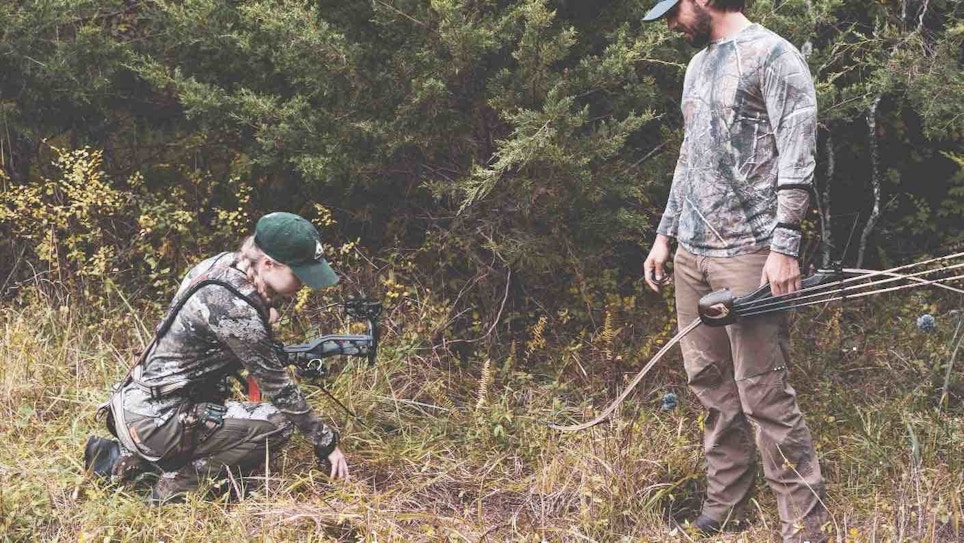Whitetail bucks make scrapes to communicate by scent. Scrapes help bucks announce their presence and show they’re ready to breed. Hunters often hunt near scrapes and make mock scrapes during the pre-rut to increase their odds of seeing and arrowing bucks.
Josh Knight, host of the Genesis Archer Show on Facebook and YouTube, hunts scrapes each fall and often arrows mature bucks. Knight, 31, started bowhunting at age 9. He has shot 20 bucks in Georgia, four of which made the Pope and Young Club’s record book. He arrowed more than half of those 20 bucks over scrapes he made (mock scrapes) or doctored.
“Hunting scrapes is my go-to strategy in October,” Knight said. “I love hunting early season paw marks. I’ve killed nice bucks using this strategy, so I’m definitely going to keep using it.”
Knight encourages beginning hunters to try hunting scrapes. “You want to stack the odds in your favor when you’re going after a big buck,” he said. “If you don’t put scent out and you don’t do mock scrapes, your chances of seeing a buck go way down.”
How to Hunt Scrapes
Step 1: Locate Scrapes, Locate Bucks
Knight scouts to find fresh scrapes from late September through October. Active scrapes appear moist, smell musky, and hold deer tracks. Large, well-used scrapes usually mean several active deer are nearby.
Tip: When conditions don’t change dramatically from year to year, whitetail bucks will scrape in the same spots annually. Bucks prefer overhead branches (i.e. licking branches) that stop growing 4 to 6 feet off the ground. Even during summer it’s relatively easy to spot the twisted ends of these overhead branches. Placing a treestand or building a natural ground blind downwind of a traditional/annual scraping area is an excellent way to ambush a rutting buck.
Step 2: Commandeer the Scrape
Knight carries trail cameras and urine-based deer attractants when scouting. When he finds a fresh scrape, he rakes the ground with a stick and applies scent. He hangs trail cameras nearby and checks the images to identify which bucks make and check the scrape. If he sees a buck he wants to pursue, then he starts hunting the area.
Tip: Don’t be surprised when checking your trail cam pics by the number of antlerless deer that visit scrapes, too. All deer, regardless of age or gender, seem to be especially interested in the overhead/licking branch.

Step 3: Setups
Bucks often check and refresh scrapes after other deer visit and scent-mark them. Knight recommends setting up 30 to 40 yards downwind of scrapes. He said bucks normally approach scrapes from downwind to scent-check them from a distance before approaching closer. Hang your stand far enough away from the scrape so a buck doesn’t get downwind from your setup, but close enough so you can make a good shot. Knight said downwind setups don’t work every time, and he has been busted more than once when setting up too close. But when it works, it’s priceless.
Tip: Knight refreshes scrapes once or twice weekly when he’s hunting. He’s also careful about odor control. He uses rubber boots and rubber gloves when making mock scrapes, and wears clothes washed in scent-free laundry detergent. He does everything possible to reduce odors, including cleansing himself with body wash before entering the woods.
Step 4: Use “Extras”
Knight uses grunt calls and rattling antlers to entice bucks to leave their beds and inspect their scrapes. Try to get your prey to come to you.
“Doing all this stuff (grunting, rattling and mock scrapes) tells the buck there’s another deer in the area, which makes it want to get up from his bed to see what’s going on,” Knight said.
Tip: As the rut picks up in early November, bucks stop checking scrapes and start chasing does. Unused scrapes lose their odor and get covered by leaves, pine needles and other debris. Knight uses a climbing treestand to hunt active scrapes throughout October, but uses different strategies in November when bucks are chasing does. Read Bowhunting 360’s article “10 Tips for Hunting the Rut” or “Rut Tactics That Really Work” at www.bowhunting360.com to learn more about those strategies.
Photos courtesy of Archery Trade Association






